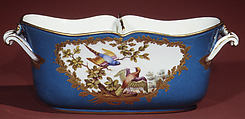Liqueur bottle cooler (seau à liqueur) (part of a service)
Manufactory Sèvres Manufactory French
Decorator François-Joseph Aloncle French
Not on view
The table services produced at Sèvres in the eighteenth century were highly prized and extremely expensive. They were not only purchased by the Crown and members of the aristocracy but also given by the king as diplomatic gifts to foreign courts and visiting dignitaries, and the esteem in which they were held did much to enhance the factory’s prestige and fortunes. Because the number of pieces composing a service was very large, the cost was enormous, but this did not deter many courtiers from ordering a dinner or dessert service, or both.
One of the most celebrated services produced at Sèvres was delivered to Louis-René-Édouard, prince de Rohan-Guémenée (1734–1803), on September 7, 1772. All of the pieces were decorated with the rich turquoise ground color known as bleu céleste and with birds encircled by an elaborate gilt wreath of oak leaves and acorns. Many of the components of the service bear the initials LPR ( for Louis, prince de Rohan), executed in two tones of gilding. The service cost the substantial sum of 20,772 livres, which was roughly equivalent to twice the annual income of a successful doctor at the time.
This liqueur bottle cooler is one of twenty-three pieces from the Rohan service now in the Museum’s collection. Originally composed of 368 pieces, the service was small in size compared to other Sèvres services, but the rich use of gilding, the expensive ground color, and the initials in two tones of gold account for its high cost.
Due to rights restrictions, this image cannot be enlarged, viewed at full screen, or downloaded.

